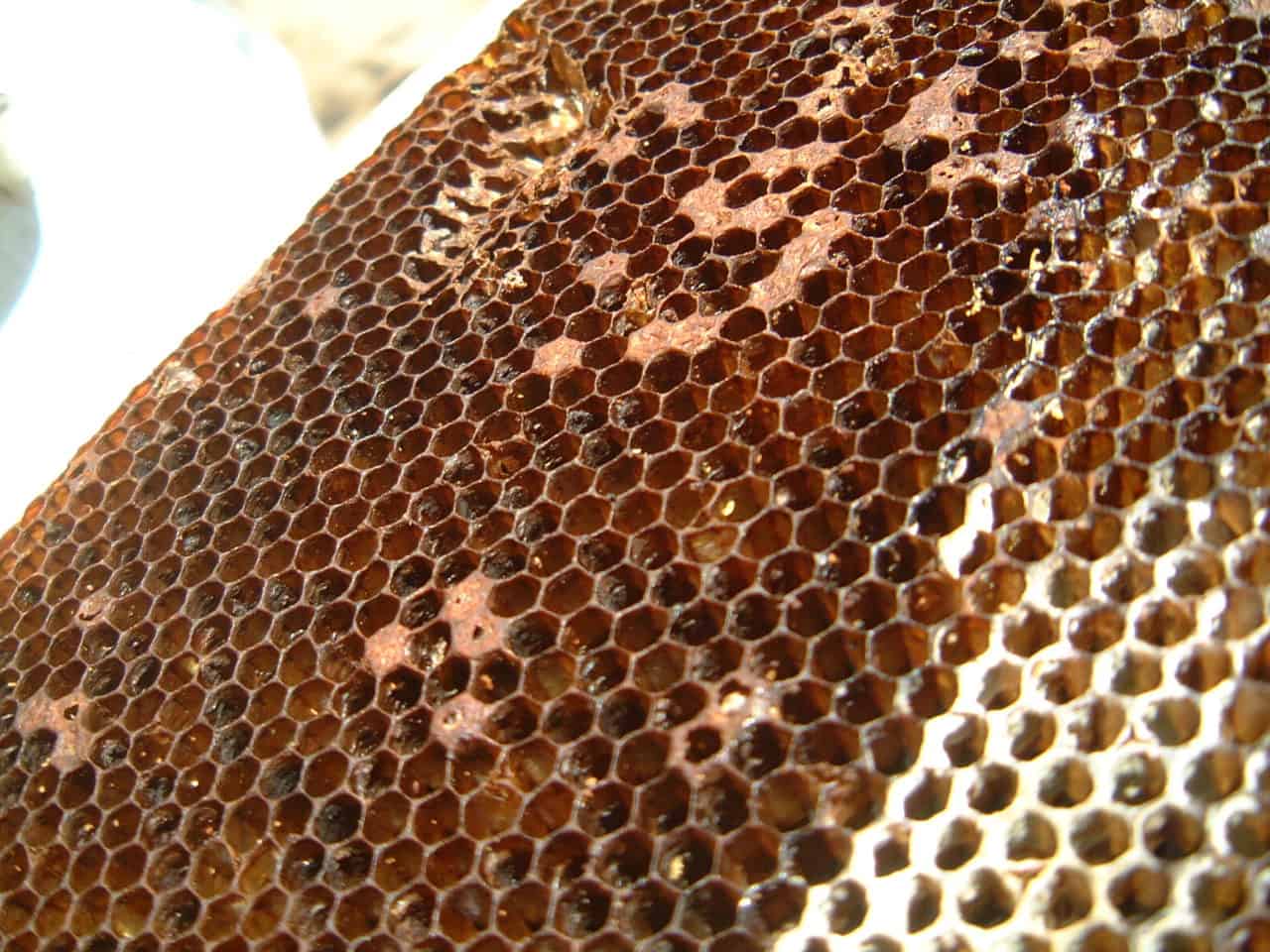A queen secretes her own combination of chemical scents, like a perfume. The queen's scent gives the worker bees cues about the hive and the condition of the queen. The scent helps control swarming, it inhibits the development of ovaries in the worker bees, it tells the workers if a queen is mated or not, and it gives workers the cue to gather around the queen and form a retinue to take care of her. The stronger the queen's chemical cue, the larger then retinue should be. A smelly queen could indicate a healthier queens, and therefore a healthier hive. We got an opportunity to…
Author: Katie Lee
Purple Brood
Liz and I spent a week in Southern California taking samples for the National Honey Bee Disease Survey. We came across purple brood – something I had never seen before. The larvae had a bright purple hue to them along their gut line. It was quite pretty. After some research, it seems that the most likely cause for purple brood is nectar from the plant Cyrilla racemiflora (common names are southern leatherwood or summer titi). It is poisonous to the brood, so beekeepers either have to move their colonies away or take the loss. Only one colony of the eight we sampled had it, so…
Autumn and the Death of Drones
The autumn is here and it is getting pretty chilly in Minnesota. The shorter days and decreased temperatures also mean doom for the poor drones. While sampling colonies this past September, we saw worker bees drag out their reluctant brothers. A drone's function is to mate, and there isn't mating going on in the winter. No mating means the fellows are no longer needed in the colony and are just a drain on the colony's resources, and they are treated as such. They are forced out of the colony and eventually die of exposure. I understand why the worker bees drag the drones out and…
Detecting American Foulbrood with a Blacklight: UPDATE
For clarification, using a blacklight is supposed to help you see if there are AFB scales in the bottom of a cell. The blacklight will make other things made of protien glow as well, so always double check that what you are seeing is a scale and not shaped like something else. An AFB scale should only be on the bottom of a cell (see picture). Be sure to look at the comb under a normal light as well, and if you are still not sure then ask or you can even send in a picture!
Smoker Plug
It has been really busy out in the Midwest recently. Liz and I visited nine beekeepers in North Dakota the past week. Once I catch up with the work, I will write more about the experience. But for now, here is something on smokers. Having your smoker puff billows of smoke out of your truck bed can prompt concerned drivers to warn you your truck is on fire. To prevent your smoker from getting you pulled over, you can either put it in a metal box or you can use something to plug the hole. To plug the hole you can use something like grass…
Midwest Bee Team
This past weekend, I made a solo trip halfway across the country back to my homeland of Minnesota where I will now be based. One of the goals of the Bee Team program is to expand and establish multiple Teams around the country. There have been requests to establish Teams in the Northeast and Southeast, which I really hope happens in the near future. But for now, the next Team will be established for Midwest beekeepers, focusing on Minnesota and North Dakota. What we will be doing in the Midwest will be slightly different than in California, since we will be primarily working with non-queen…
Eric Mussen
If you want to learn more about Eric, start here. Also, don’t forget to take the surveys!!
Queen Season
It is queen producing season! The first grafts happened late February and now thousands and thousands of nucs (mini colonies) are scattered across the Sacramento Valley. Normally, how it works is the beekeepers make up the tiny colonies with about a spam can of bees (that is the actual measurement in a few cases), put in a cell with a queen about to emerge, then place the nuc out into the field so the queen can mate a few days post-emergence. The beekeepers will wait until the new queen is laying eggs and generally looks healthy, then catch and cage the queen, and ship her…
Spring Sampling Season
Our spring sampling season is almost finished (in Northern CA, spring starts in January - coming from the Midwest, I initially found that very confusing) . It has been a marathon to try and get all the bees sampled before the queen breeding season starts. We've been sampling colonies for Varroa, Nosema, viruses, and hygienic behavior that the beekeepers picked out as potential queen mother colonies. The data is only really useful if they get it prior to the start of their grafting, so we have been working pretty much non-stop since the end of January to get the information to them in time. We…
Bees in bare almonds
Right now, beekeepers are pretty much done with moving bees across the country and into the almonds. The beekeepers we work with are doing the same thing - moving colonies from their different yard locations across Northern California into the almonds. Now, everyone is anxiously awaiting bloom. The Blue Diamond Almond company has a website to estimate bloom time. Almonds are so dependent on bees to get a crop and beekeepers are paid a premium price for their colonies (why some beekeepers come in from the east coast), so this is a really anxious time for both parties. Everyone just hopes for good enough weather…
